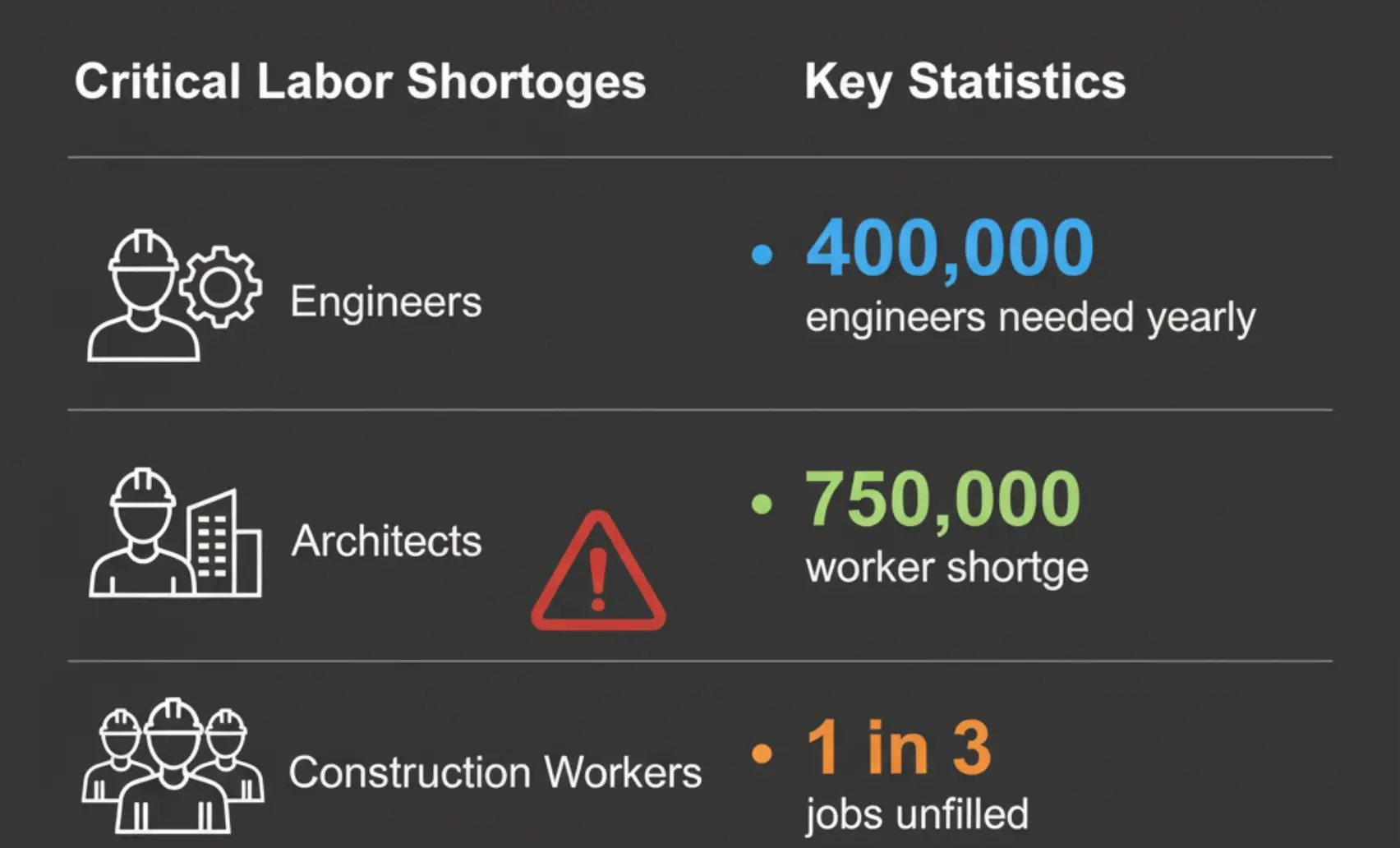
The Architecture, Engineering, and Construction (AEC) industry is entering 2026 with both opportunities and challenges. AEC outsourcing outlook shows growth in construction spending, but severe skill shortages across engineering and technical roles. As public infrastructure projects expand under federal funding, competition for qualified talent will intensify.
For AEC leaders, the next few months are critical. Building and training a remote AEC team in Q4 2025 positions your firm to stay agile, meet project demands, and control costs when the 2026 upswing arrives. This article explores the numbers, trends, and strategic advantages of outsourcing AEC professionals, especially remote architect assistants, through Remote AE, your partner for dedicated virtual AEC staffing.
The American Institute of Architects (AIA) Consensus Forecast projects a 1.7% rise in nonresidential construction spending in 2025 and a modest 2.0% increase in 2026.
At the same time, the Infrastructure Investment and Jobs Act (IIJA) continues to inject $3.4 billion into modernization and land port projects across 12 states. These federal investments sustain steady construction activity even when commercial demand softens, keeping the labor market tight.
A 2024 BCG study shows the U.S. must add 400,000 new engineers each year, yet one in three positions goes unfilled through 2030. In parallel, the Associated Builders and Contractors (ABC) reports a construction worker shortage of up to 750,000, a figure worsened by restrictive immigration policies.
In civil, electrical, and structural engineering, competition for qualified professionals is fierce. With many public projects underway, private AEC firms face higher wage pressure and slower recruitment. This widening skills gap is one of the key drivers behind the surge in AEC outsourcing heading into 2026.
AEC firms operate on precision and deadlines. Every design delay, modeling backlog, or documentation gap translates into lost revenue. Yet hiring experienced professionals locally is increasingly impractical.
Here’s why:
As these factors converge, even large firms are turning to remote AEC professionals to maintain workflow continuity and project quality.
Outsourced AEC talent, such as a Virtual Architect Assistant, Revit modeler, or Remote Project Coordinator, fills gaps quickly while preserving in-house bandwidth for client relations and oversight.

Outsourcing has become more than a temporary fix; it’s a strategic workforce model. For AEC firms, remote professionals can now handle much of the technical and administrative work once limited to office teams.
Tasks such as CAD drafting, architectural rendering, space planning, 3D modeling, BIM coordination, takeoffs, scheduling, and document control can all be managed by virtual architect assistants working securely from anywhere. This approach frees up your senior engineers and architects to focus on design intent, client communication, and compliance.
By partnering with Remote AE, you can access a vetted global pool of architects, architectural technicians, and design support staff, each verified, niche-experienced, and trained in AEC software ecosystems like AutoCAD, Revit, Civil 3D, and Primavera. It’s the smartest way to stay fully staffed without stretching your local payroll.
Key benefits:
The economics of outsourcing are clear. Hiring local talent amid a workforce shortage drives wages up. Outsourcing gives you predictable costs and immediate scalability.
Advantages AEC firms report:
For project managers and principals, this means fewer hiring fires, steadier margins, and more bandwidth to pursue new clients.
By the end of 2025, the industry’s challenges will collide: construction demand steady, labor costs high, and talent scarce. Firms that wait until 2026 to start outsourcing will compete for the same limited remote talent pool, paying higher rates and facing onboarding delays.
Here’s why preparing now matters:
Think of Q4 2025 as your talent preconstruction phase, the setup that ensures a smoother build season in 2026.

Remote AE is a trusted AEC outsourcing partner with over 15 years of specialized experience in staffing for the architecture, engineering, and construction industries. We help firms overcome hiring bottlenecks by providing dedicated virtual professionals who are skilled, verified, experienced in remote work, and aligned with your project needs.
Our process goes beyond just filling roles. We match every professional based on:
Our goal is simple: to help AEC firms work smarter, scale faster, and deliver projects on time, without inflating costs or compromising quality.
We cover the full project cycle with remote experts who can integrate seamlessly into your team:
Each virtual architect assistant or remote design technician works exclusively with your team, ensuring consistency, confidentiality, and alignment with your design and documentation standards.
Remote AE simplifies outsourcing with a process designed for busy project managers:
Partner with Remote AE to access verified, experienced, and dedicated architectural, engineering, and virtual candidates, ready to support your projects remotely. Start building your remote AEC team today with RemoteAE.